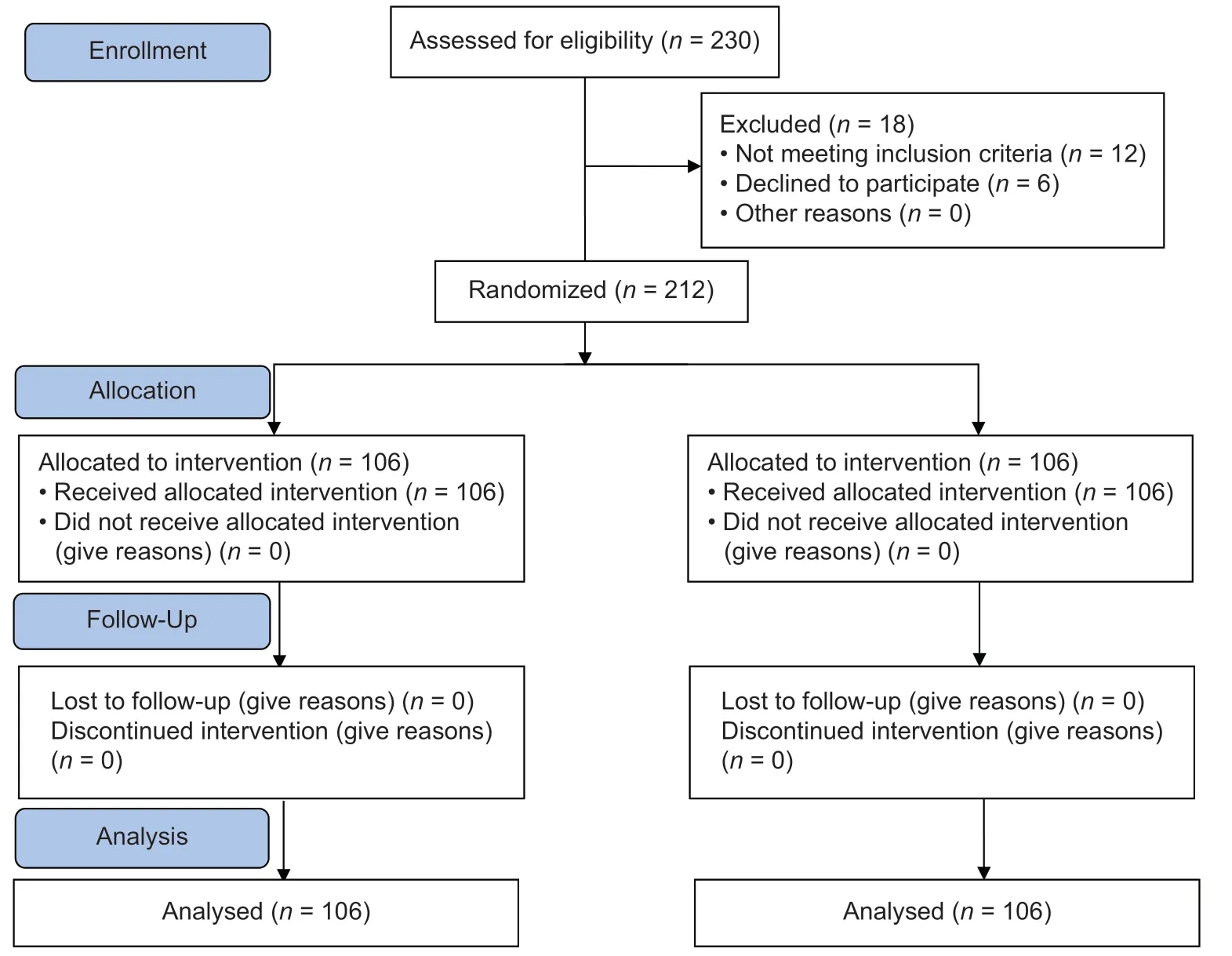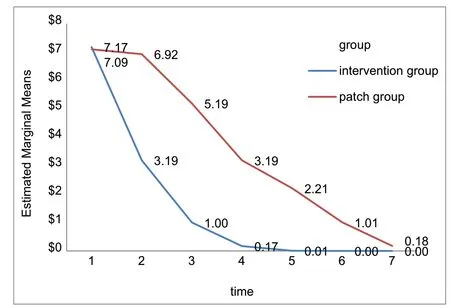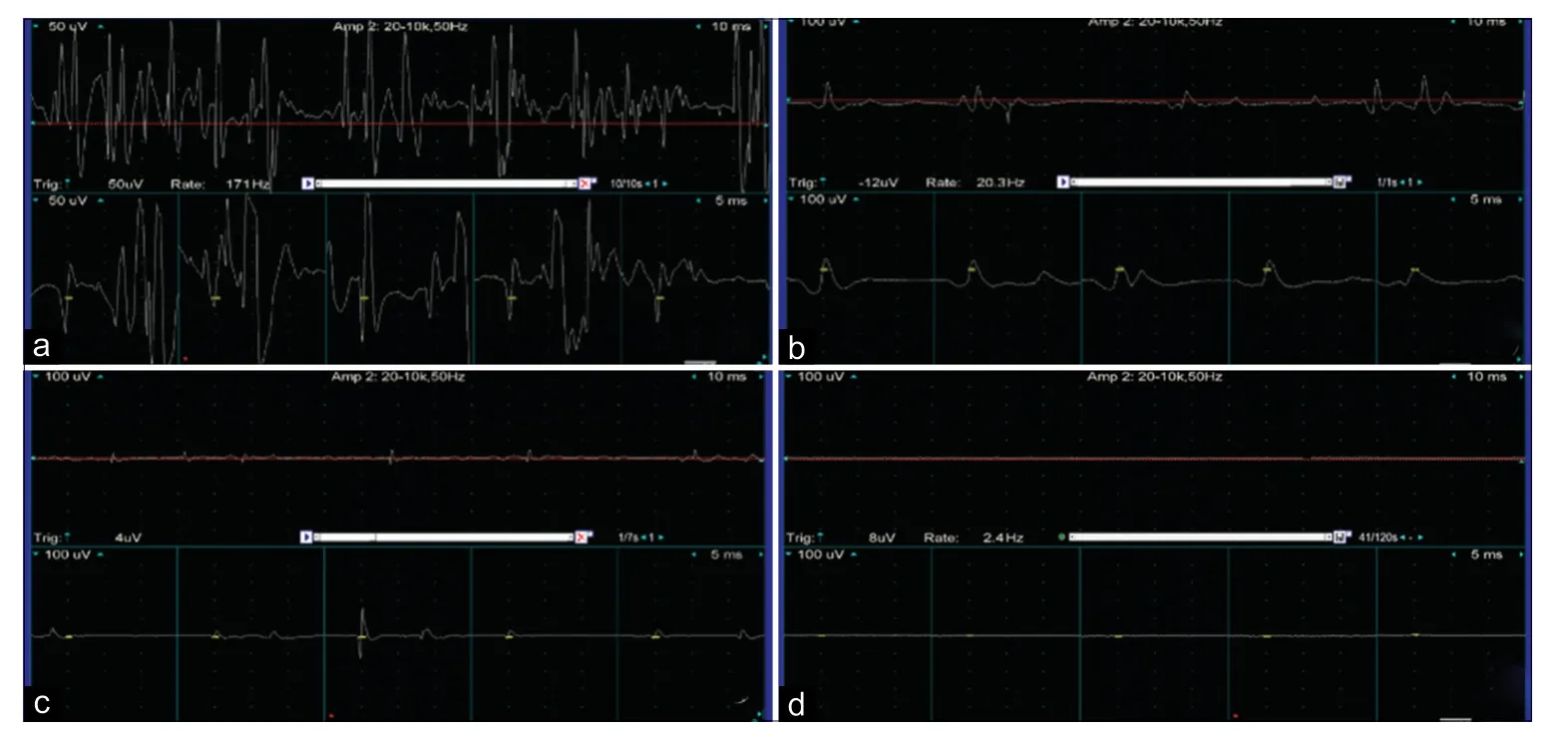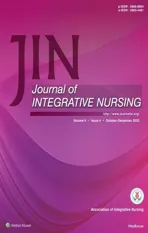Dredging hand Yang meridians with deep tissue massage combined with neck movement in stiff-neck syndrome:A randomized controlled trial
2023-01-07XueguoSUNZonghuaQIYingLIUYanLIXianliDOULingyunZHANG
Xueguo SUN,Zonghua QI,Ying LIU,Yan LI,Xianli DOU,Lingyun ZHANG
1Department of Gastroenterology,The Affiliated Hospital of Qingdao University,Qingdao,China;2Electromyogram Room,The Affiliated Hospital of Qingdao University,Qingdao,China
ABSTRACT Objective:The objective of this study is to observe the therapeutic effects of dredging hand Yang meridian with deep tissue massage combined with neck movement on stiff-neck syndrome.Materials and Methods:This is a randomized controlled trial.The consecutive patients with the stiff-neck syndrome were randomly allocated into the intervention group and patch group (1:1) according to the random number table.The intervention group was treated with dredging hand Yang meridian with deep tissue massage combined with neck movement once a day for 3 days,while the patch group therapy was treated with a 3-patch therapy and every patch included 24-h patch and 24-h patch-free.A needle electromyogram would be exerted if the patients were at their willingness in different stages.The pain of patients was assessed by Visual Analog Scale in the two groups at every 24 h time point.Results:Finally,212 patients completed the trial,106 in each group.The curative rate in the intervention group was higher than in the patch group (99.06% vs.84.91%,χ2=0.890,P < 0.01).Repeated measures of the general linear model showed a significant difference in pain score within the subject-factors (factor of time F=4548.577, P < 0.001;factor of time-group F=490.034, P < 0.001).There was a significant difference between groups regarding pain score (F=3016.315, P < 0.001).Conclusion:Dredging hand Yang meridian with deep tissue massage combined with neck movement is better than patch therapy in stiff-neck syndrome,with a shorter duration and instant effects.
Keywords: Electromyogram,massage,meridian,movement,neck pain,stiff-neck syndrome,traditional Chinese medicine
INTRODUCTION
Stiff-neck syndrome is manifested as the sharp onset of severe and persistent pain in the cervical region,which is rigidly held in the erect central position and resists the least movement,active and passive,in any direction,the pain being greatly augmented by such attempts.[1]It is mostly caused by improper sleep posture,an uncomfortable pillow,cold attacking the neck,or the strain of neck muscles during sleep.It is very common in clinics and can last several days,weeks,or even months.The severe stiff-neck syndrome often interferes with work and life.Nowadays,there are many kinds of methods to treat the stiff-neck syndrome,such as massage,scrapping therapy,cupping,acupuncture,and so on,[2-8]but their efficacy has been controversial.Therefore,we conducted a randomized controlled trial (RCT) to compare the therapeutic effects of dredging hand Yang meridian with deep tissue massage combined with neck movement versus patch therapy on stiff-neck syndrome.
MATERIALS AND METHODS
Ethical considerations
This study was conducted in accordance with the World Medical Association Declaration of Helsinki.Ethical approval was received from the Affiliated Hospital of Qingdao University in June 2019,with approval number QYFYWZLL26254,after which recruitment was launched.The protocol was registered in the ClinicalTrial.gov (Registration number: NCT04815421).The aim and significance of the study were completely explained to the participants before the study,and patients were assured that their information was kept confidential,and the final report will be anonymous.
Study design
This present study was a RCT conducted on patients with the stiff-neck syndrome who were referred to the rehabilitation/surgical department of the Affiliated Hospital of Qingdao University from June 3,2019,to April 3,2021.Patients were allocated into the control or intervention group according to the random number table at an allocation rate of 1:1.Because the nature and method of therapy were specific in each group,blinding of patients and the medical practitioner was impractical.However,the data analyst was blinded to the group assignment of the patients.
Diagnostic criteria
The diagnostic criteria of neck stiff syndrome are as follows: (1) Acute onset of severe pain and stiffness in the one-sided neck after sleep;(2) Mostly because of bad sleep posture or cold in the neck,shoulder,or head;(3) Pain or discomfort can radiate to head,arm and back;(4) Any attempt to move neck can obviously exacerbate the pain;(5) The head slants to the affected side;(6) Without neck injury history or other relative systematic diseases;(7) Neck X-ray film has no positive signs such as degenerative lesions of the cervical spine;(8) Trachelismus and rhomboideus major/minor,levator scapulae accessible lumps or streak in muscle.All criteria conformed to the prescription in criteria of diagnostic and therapeutic effect of orthopedic and traumatologic diseases and syndromes in traditional Chinese medicine.[9]
Inclusion criteria
The inclusion criteria were as follows: (1) Patients met the above diagnostic criteria;(2) the onset of symptoms and signs were less than 24 h;(3) Male or female aged from 14 to 60 years;(4) No other therapy before enrolled;(5) Patients had a willingness to participate the study.
Exclusion criteria
The exclusion criteria were as follows: (1) Stiff neck patients who had been diagnosed with cervical vertebra or cervical spondylosis;(2) Patients who suffered from systemic collagen immune diseases or other acute or chronic infection;(3) Patients who used pain-killer drugs (which may affect the outcome evaluation);(4) Patients who dropped out in follow-up visit;(5) Aggravation of disease or complications during the study.
Sample size calculation
We took the anticipated prevalence (P) of the stiff-neck syndrome as 30%.Most episodes of acute neck pain will resolve with or without treatment,so we estimated the occurrence rate to be about 15%.[10]For a 95% confidence interval and with 5% precision,the sample size thus estimated was 204 participants using the formula 4P(1 -P)/d2;wherePrepresents the expected prevalence anddrepresents precision.Assuming a 5% nonresponse rate,the final sample size was determined to be 214.
Interventions Intervention group
Patients in the intervention group were treated with dredging the same-side three-hand Yang meridians through deep tissue massage in combination with neck movement.The sequence of massage is the large intestine meridian of hand Yangming (LI),the small intestine meridian of hand Taiyang (SI),and Sanjiao meridian of hand Shaoyang (SJ).The specific operation was as follows.First,the gliding and percussion techniques of deep tissue massage were performed on the hand Yang meridians of the wrist and dorsum of the hand (including the second,fourth and fifth metacarpal bone areas) at the affected side.Second,the second,fourth,and fifth fingertips of the affected-side hand were kneaded.Third,the patients were encouraged to try their best to roll their necks to the most tolerable degree during dredging the meridians.The massage would continue until the meridian route was relatively smooth,soft,and thermal.The total time was about 3-5 min according to the tolerance of each patient and the smooth of hand Yang meridians.The frequency of massage was once a day for 3 days.
Patch group
Patients in the patch group were treated with Compound Nanxing Patch (mainly consisting of Baizhi (RadixAngelicae Dahuricae),Jingjie (HerbaSchizonepetae),Xixin (HerbaAsari),raw Tiannanxing (RhizomaArisaematis),Dingxiang (FlosCaryophylli),Bingpian (BorneolumSyntheticum),Ruxiang (Olibanum),Chenpi (PericarpiumCitriReticulatae),menthol,etc.) on the affected region such as shoulder,neck or back,and no more than three pieces were used once.The patch was pasted every 2 days,three times in 6 days in total.It is noted that each patch was kept on the affected region only for 24 h and then was removed,keeping 24-h patch-free.
Patients in the intervention group had a needle electromyogram (EMG) on the 1st,2nd,and 3rdday during the treatment if they agreed to be checked.
Observation indexes Therapeutic effect
The therapeutic effect on stiff-neck syndrome is evaluated based on criteria of diagnostic and therapeutic effect of orthopedic and traumatologic diseases and syndromes in traditional Chinese medicine.[9]Cure: Absence of neck stiffness and soreness,and free functional activities.Improvement: partially functional activities with mild to moderate pain.Failure: No improvement or alleviation of neck stiffness and agony.Total effective rate=Cured rate+Improvement rate.
Visual Analog Scale score
Neck pain was evaluated according to the Visual Analog Scale (VAS) at the onset and every 24 h time point.The meaning of the numbers on the VAS was explained to patients,and each individual was asked to mark his/her perceived pain intensity on a scale bar between 0 and 10,with 0 indicating no pain and 10 representing the severest pain ever experienced.[11]
Statistical analysis
IBM SPSS Statistics for Windows version 17.0(SPSS Inc.,Chicago,IL,USA) was used for statistical analysis.Measurement data in conformity with the normal distribution were expressed by mean ± standard deviation (x¯± s).The comparison between the groups was processed by repeated measurement of the general linear model.The therapeutic effect between the two groups was processed by the Rank-Sumttest.P< 0.05 indicated a statistical significance.
RESULTS
Totally,230 patients were selected according to inclusion criteria and examined by a physician/surgeon.After the elimination of 12 patients (9 patients had a history of cervical spondylosis;1 patient had rheumatoid arthritis and 2 patients used painkillers) who met any of the exclusion criteria,all participants were familiarized with the test procedure and 6 patients disagreed to participate in the study.Finally,212 patients completed the study.The CONSORT 2010 Flow Diagram of participants in each group is shown in Figure 1.
General data between the two groups
There was no significance between the two groups regarding gender (χ2=0.890,P >0.05),age (t=-1.242,P >0.05),and VAS score (t=0.759,P> 0.05) [Table 1].
Comparison of therapeutic effects between the two groups
The therapeutic effect in intervention group was better than that in patch group (Z=-3.784,P <0.001) [Table 2].
The difference of pain score within subject-effects of time was significant (P< 0.001).The difference of pain score within the subjects-effects of the time-group was also significant (P< 0.001).The difference of pain score between the subjects-effects of the group was significant (P< 0.001) [Table 3].
Note:Data are nonnormal distribution tested by SW Test,Machly W=0.175,P< 0.0001.
The estimated marginal means of pain score between the intervention group and control group were as follows in Figure 2.The VAS score of pain in the two groups both decreased,but the VAS score of pain in the intervention group had a drastic decrease.Every pain score of neck pain at every 24 h time point had an obvious change with time going during the study.The intensity of pain improved significantly in the two groups.
DISCUSSION
Traditional Chinese Medicine believes that stiff-neck syndrome is caused by wind,cold or bad pillow,which incurs the Qi and/or blood stagnation or stasis in the neck,back,or shoulder region.[12]Stiff neck syndrome belongs to Arthralgia Syndrome and originated fromHuangdi's Canon of Internal Medicinethat can be treated by dispelling the cold,dampness or wind.[13,14]Massage is an external treatment method that the operator applies various manipulations onto the meridians and collaterals,acupoints or specific parts of the body to prevent and cure diseases.[15]Flapping,patting pressing,kneading,and grasping along meridians and acupoints increase strength to the skin,muscles,and bones.[4]Previous studies have shown that acupoint treatment on neck pain is effective,[3,4,6,7]so are exercise combined with moving cupping,and “Three Parts,Four Points,Five Manipulations”.[8,16]In our study,dredging hand Yang meridians with deep tissue massage in combination with neck movement on stiff-neck syndrome that we used is an integrative method,with a total effective rate of 100%.Compared with the patch group,the duration of the intervention therapy is the shorter (1 day) and the pain score decreased at least 3 score after the 1stintervention.Deep tissue massage is a specific and independent method of massage therapy,with a specific set of principles and techniques.[17]As defined by Riggs as,“The understanding of the layers of the body,and the ability to work with tissue in these layers to relax,lengthen,and release holding patterns in the most effective and energy efficient way possible within the client’s parameters of comfort.”[18]Massage manipulations plus functional training for scapulohumeral periarthritis can effectively alleviate pain and restore the functions of the shoulder joint.[19]Manual pressure technique could be significant for clinical practice,as it could serve as an effective alternative for the treatment of myofascial pain.[20]Manual pressure is very important factor in deep tissue massage,the degree of it depends on the practical experience of the operators and the tolerance of the patients.Pain during any movement or physical activity is a concept once overlooked apart from general rest,and breakthrough pain.[18]

Figure 1: CONSORT 2010 flow diagram

Table 1: The general data of the two groups

Table 2: Comparison of clinical effects between the two groups

Table 3: Pain score of the patients between the intervention group and control group (x¯±s)

Figure 2: The estimated marginal means of pain score between the intervention group and control group
Movement is often prescribed to help decrease pain and restore/improve body function.[11,16,21]Grossetal.[22]did a systemic review of 51 RCTs (2920 patients with neck pain) of assessing the effects of manipulation and mobilization,and concluded that cervical manipulation and mobilization had similar improvements in pain relief.The effects of exercise were greater locally at the site of pain and less so at remote regions.[23]The method of distal acupoints along the meridian combined with movement is often used to treat clinical pain.[8]These evidence indicate that the movement or mobilization is very important in the recovery of pain.
The sayings of “where the meridian goes through,where can be treated” is well-known;hence,the hand Yang meridians which go through the neck and shoulder region can cure stiff-neck syndrome.[5]Yangming (hand or foot) meridian is the most effective in getting rid of wind or cold,so we start from the hand Yangming meridian first.The route of meridian is relatively fixed,but the depth is not fixed.Therefore,we dredge the hand Yang meridian with the gliding or/and percussion techniques on the hand Yang meridian region deeply almost to the bone surface so long as the patients can tolerate the pain of massage.Meanwhile,we ask the patients try their best to turn their neck to the contralateral side of the stiff neck.Massage will continue until the meridian route was relatively smooth,soft and thermal.Dredging meridians with deep tissue massage can excite the meridian Qi of the human body,guide the meridian Qi of the whole body to flow upward,and discharge the pathogens.We massaged the hand Yang meridians with deep tissue massage to dredge the Qi and blood of meridians and dispel the coldness,dampness,and wind accumulated in the meridians in deep tissues (muscles,fascia,or deeper to bone) and got the instant effects of relaxing the stiff neck and shoulder and obvious pain relief.
Needle EMG is the technique of recording and analyzing the electrical signals derived from individual muscle fibers of motor units,at rest and during voluntary contraction,using a needle recording electrode inserted into the muscle.[24]Needle EMG records and amplifies the electrical signals generated from resting or contracting muscle fibers,and interprets the signals to diagnose the function of the muscle.In the present study,we used EMG to show the degree of tension of the muscle fibers.The less pain,the relaxer the muscle was and the EMG accordingly showed that the frequency and magnitude of the muscles were less.The EGM offered objective evidence of muscle’s tension or spasm [Figure 3].
The limitation of the current study is the small sample size,but this could be addressed in future studies.Moreover,we recommend a longer follow-up of the patients to trace the effects.
CONCLUSION
Dredging Hand Yang meridian with deep tissue massage combined with neck movement is effective in the treatment of stiff-neck syndrome.It is a simple and feasible method and worthwhile to disseminate in hospitals,community health care services,and home.
Declaration of patient consent
The authors certify that they had obtained all appropriate patient consent forms.In the form,the patients have given their consent for their images and other clinical information to be reported in the journal.The patients understand that their name and initial will not be published,and due efforts will be made to conceal their identity,but anonymity cannot be guaranteed.
Acknowledgments
We have been appreciated to the help of Doctor Lingxin Kong(Acupuncture Department).
Financial support and sponsorship
Nil.

Figure 3: EMG picture of patient suffering from different pain.(a) The EMG picture of patient suffering from severe pain (the first visit of the physician).(b) The EMG picture of patient suffering from moderate pain (after one intervention).(c) The EMG picture of patient suffering from mild pain(after two interventions).(d) The EMG picture of patient suffering from no pain (after three interventions).EMG=Electromyogram
Conflicts of interest
There are no conflicts of interest.
杂志排行
Journal of Integrative Nursing的其它文章
- Evaluation of adolescent/youth-friendly sexual and reproductive health services: A 7-year systematic review from January 2016 to April 2022
- Symptom experience in patients with cancer-related fatigue: A systematic review and meta-synthesis
- Drivers of early marriage and teenage pregnancy in Kenya and Uganda during COVlD-19 lockdown period:A systematic review
- Quality of life and psychological impact among chronic disease patients during the COVlD-19 pandemic
- Job satisfaction and organizational commitment among nurses working on temporary versus permanent jobs at a tertiary care teaching hospital,Uttarakhand,lndia
- Nursing students’ experiences of horizontal violence and occupational belonging during clinical placements
